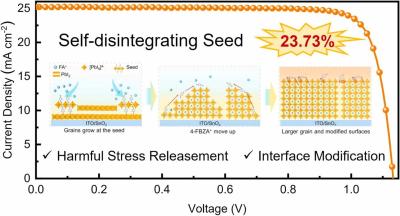Researchers from China's Southwest Petroleum University, Beijing Institute of Technology, Chongqing University, National Center for Nanoscience and Technology and Tongwei Solar have designed a perovskite solar cell with remarkable perovskite film quality through the 'self-disintegrating seed' strategy. The device achieved both an impressive fill factor values and remarkable stability.
The researchers, in fact, report what they say is one of the highest fill factor values ever achieved for a perovskite solar cell, by reducing its nonradiative recombination and residual stress through what they called a self-disintegrating seed strategy.
They explain that the strategy achieved a synergistic effect of morphology optimization, interface modification and stress releasement through functional cations released from seed. The scientists say that the seed in the perovskite precursor has been previously shown to induce perovskite grain growth and increase grain size, but previous studies have primarily focused on regulating perovskite crystallization and morphology. They team believes that for perovskite solar cells, the issues of defects at the interface and residual stress within the film are equally critical and challenging to address using conventional seeding strategies.
The scientists aimed to overcome the limitations of the seeding strategy by using a perovskite material known as 2D (4-FBZA)2PbI4, which embeds a self-disintegrating seed to enhance the crystallization process of the perovskite film. The material can bind with lead iodide (PbI2), providing large-size nucleation centers for perovskite grains, thereby enhancing grain size and crystallinity.
The team used X-ray photoelectron spectroscopy, Kelvin probe force microscopy, density functional theory calculations, and other characterizations to show that (4-FBZA)2PbI4 disintegrates during perovskite grain growth, releasing 4-FBZA+ which at the same time migrates to the interface, passivating defects, and stabilizing the perovskite lattice through interactions with FA+ and [PbI6]4-, achieving interface modification of perovskite films.
According to the research team, the self-disintegrating seed releases harmful tensile stress in the perovskite film, improving carrier lifetime and promoting hole transport.
The scientists designed the cell with an indium tin oxide (ITO) substrate, an electron transport layer (ETL) based on either tin oxide (SnO2), the perovskite absorber, a hole transport layer (HTL) relying on Spiro-OMeTAD, and a silver (Ag) metal contact.
Tested under standard illumination conditions, the device achieved a power conversion efficiency of 23.73%, an open-circuit voltage of 1.133 V, a short-circuit current density of 25.21 mA cm2, and a fill factor of 83.07 %. For comparison, a reference device designed without the proposed self-disintegrating seed strategy achieved an efficiency of 22.73%, an open-circuit voltage of 1.117 V, a short-circuit current density of 24.78 mA cm2.
The research group explained that devices prepared using this strategy exhibit commendable long-term humidity stability, with unencapsulated devices retaining 90% of their initial PCE after aging for over 2000 h in the air with 60% relative humidity.
This study set out to extend the seed strategy to address interface modification and stress releasement, addressing the shortcomings of traditional seeding approaches and expanding seed research in the field of perovskite solar cells.




